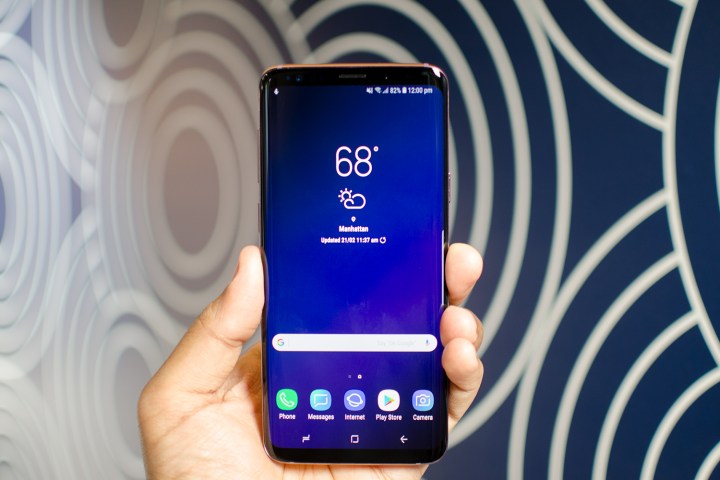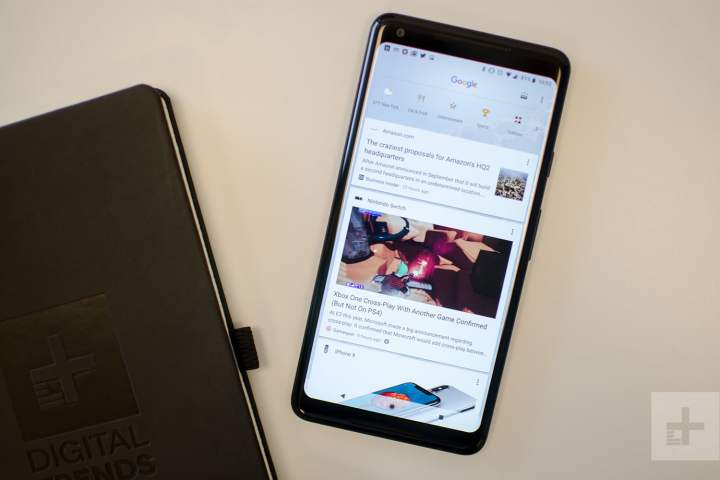
Samsung opened this year’s Mobile World Congress with its new flagships, the Galaxy S9 and S9 Plus. Samsung’s latest and greatest are getting a lot of attention, and for good reason: They pack some of the most impressive specs of any smartphone we’ve ever seen.
The Pixel 2 XL, on the other hand, is one of our favorite Android smartphones of all time. With the Pixel 2 XL you get a best-in-class camera, stock
Suffice to say you can’t go wrong with either the
Specs
| Galaxy S9 Plus | Pixel 2 XL |
|
| Size | 158.1 x 73.8 x 8.5 mm (6.22 x 6.84 x 0.33 inches) | 157.9 x 76.7 x 7.9 mm (6.22 x 3.02 x 0.31 inches) |
| Weight | 189 grams (6.66 ounces) | 175 grams (6.17 ounces) |
| Screen | 6.2-inch Super AMOLED display | 6-inch P-OLED display |
| Resolution | 2,960 X 1,440 (529 ppi) | 2,880 x 1,440 pixels (538 ppi) |
| OS | Android 8.0 Oreo | Android 8.1 Oreo |
| Storage | 64GB | 64GB, 128GB |
| MicroSD card slot | Yes (up to 400GB) | No |
| NFC support | Yes | Yes |
| Processor | Snapdragon 845, with Adreno 630 (U.S.)
Exynos 9810 (International) |
Snapdragon 835, with Adreno 540 |
| 6GB | 4GB | |
| Connectivity | LTE, GSM, CDMA, HSPA, EVDO, 802.11a/b/g/n/ac Wi-Fi | GSM, CDMA, HSPA, EVDO, LTE, 802.11a/b/g/n/ac Wi-Fi |
| Camera | Dual 12MP with OIS rear, 8MP front | 12.2MP rear, 8MP front |
| Video | Up to |
Up to |
| Bluetooth | Yes, version 5.0 | Yes, version 5.0 |
| Fingerprint sensor | Yes — Also has Intelligent Scan (Facial/Iris recognition) | Yes |
| Other sensors | Accelerometer, barometer, gyro, geomagnetic, heart rate, proximity, iris, pressure | Gyroscope, accelerometer, compass, proximity sensor, barometer |
| Water resistant | Yes, IP68 rated | Yes, IP67 rated |
| Battery | 3,500mAh
Fast-charging Wireless Charging |
3,520mAh
Fast-charging |
| Charging port | USB-C | USB-C |
| Marketplace | Google Play Store | Google Play Store |
| Colors | Midnight Black, Titanium Gray, Lilac Purple, Coral Blue | Just Black, Black & White |
| Availability | AT&T, Verizon, Sprint, T-Mobile, Unlocked | Google Store, Verizon, Best Buy |
| Price | $840 | $850 |
| DT review | Hands-on review | 4 out of 5 |
The
When it comes to internals, the Pixel 2 XL is starting to show its age. It houses the Snapdragon 835 processor, which is perfectly acceptable, but no where near as fast or efficient as the Snapdragon 845. It also features a paltry 4GB of
In terms of storage, the Pixel 2 XL just can’t compare to the Galaxy S9 Plus. While the Galaxy S9 Plus only offers a 64GB storage option compared to the 64GB and 128GB options on the Pixel 2 XL, Samsung’s smartphone has a MicroSD slot that supports up to 400GB of external storage.
In our book, the Galaxy S9 Plus wins on overall hardware. The extra
Winner: Galaxy S9 Plus
Design and display

Take a look at the
Composed of a shatter-resistant Gorilla Glass surrounding an aluminum frame, the Galaxy S9 is a beautiful and somewhat-durable flagship. Its 6.2-inch edge-to-edge display has slightly smaller bezels than the
Flip the Galaxy S9 Plus over and you’ll quickly spot the differences between it and the S8 Plus. This year’s Samsung flagship features a dual camera array for the first time. You’ll also find a more conveniently place fingerprint sensor.
The Pixel 2 XL, on the other hand, features a 6-inch POLED display with some pretty chunky bezels. Instead of glass, Google opted for an aluminum frame on the Pixel 2 XL. While it’s durable, it definitely doesn’t look as refined as the competition.
On the back of the Pixel 2 XL you’ll find a single
On the bottom of both the Galaxy S9 Plus and Pixel 2 XL you’ll find a USB-C charging port. On the
The Galaxy S9 Plus is IP68 rated to withstand up to 5 feet of water for 30 minutes, and the Pixel 2 XL is IP67 rated for up to 3 1/2 feet.
While design may be subjective, the Galaxy S9 still wins this category for its curved display, 3.5mm headphone jack, and higher IP rating.
Winner:
Camera
This year, Samsung finally joined the dual-camera bandwagon on the Galaxy S9 Plus. The phone features two 12MP lenses. The primary lens has autofocus, optical image stabilization (OIS), electronic image stabilization (EIS), and a dynamic aperture. The secondary lens has many of the same specs, but with a stationary F2.4 aperture.
While a dual-camera array is not overly impressive on its own, Samsung definitely managed to delight us with its first-of-its-kind dual aperture. Instead of relying on software fixes for poor exposure like other smartphones, Samsung created a lens that can mechanically adjust aperture from f/1.5 to f/2.4. In theory at least, this means much better low-light shots.
To be quite honest, the front-facing camera on the Galaxy S9 Plus doesn’t seem much different than last year’s model. It features an 8MP camera with auto focus and an f/1.7 aperture, which should allow you to get pretty good shots, even in low light.
In addition to hardware upgrades, you’ll find some pretty significant software improvements on the Galaxy S9 Plus. Samsung’s answer to Apple’s Animoji, called AR Emoji, makes its debut on the Galaxy S9 Plus. The feature uses the front-facing camera to capture your emotions and transpose them on different emojis, Disney characters, and even Bitmoji-esque avatars that you can customize to better match your own features. While it’s a pretty cool addition, it doesn’t quite compare to Apple’s Animoji.
Google took a different approach to its camera on the Pixel 2 XL. Rather than adding dual lenses, the company chose to create ingenious software solutions to improve images in any lighting condition. It also added Pixel Visual Core, a separate imaging sensor that can dramatically improve photos from third-party apps.
On the Pixel 2 XL, you’ll find a 12.2MP camera with an f/1.9 aperture. Optical image stabilization and electronic image stabilization are included to counteract jerky hand movements, as well as dual-pixel phase-detection and laser autofocus. There’s an 8MP HD front-facing camera on the Pixel XL 2 that takes pretty impressive selfies.
Both the Galaxy S9 Plus and the Pixel 2 XL feature an AI camera assistant. You’ll find Bixby Camera on the Samsung, while Google Lens is on the Pixel 2 XL. Although both assistants can provide contextual information on objects and locations, Google Lens is definitely more robust and provides a significantly superior user experience.
When it comes to video, Samsung has made some pretty impressive strides with the Galaxy S9 Plus. One of the most impressive new features on the Galaxy S9 Plus is Super Slow-mo, which allows you to shoot video at an astonishing 960 fps in 1080. There’s also slow motion at 240 fps at 1080p, and you can shoot
Video specs on the Pixel 2 XL aren’t as impressive as you’ll find on the Galaxy S9 Plus. Google’s flagship supports shooting in
In terms of overall image quality, Google appears to have found the sweet spot between hardware and software on the Pixel 2 XL. It snagged a DxOMark rating of 98 last year, the highest ever for a
Since we haven’t managed to run the Galaxy S9 Plus through its full paces, its tough to declare a winner in this category. Although the Pixel 2 XL is a proven champion, Samsung has never fallen far behind and the additions to this year’s Galaxy S9 Plus may just push it over the top.
Winner: Tie
Battery life and charging

The
While both phones support fast charging, the
The Galaxy S9 Plus also has wireless charging, a feature the Pixel 2 XL unfortunately lacks. It’s a feature we’re coming to expect on flagship phones, and we hope Google steps up to the plate with the next-generation Pixel.
While it’s a close call for this category, the
Winner:
Software

The Pixel 2 XL, on the other hand, offers its own AI assistant called Google Lens. You’ll also find AR stickers in the camera app featuring characters from Star Wars: The Last Jedi and Stranger Things. And we’d definitely be remiss if we didn’t mention Active Edge, which allows you to squeeze the phone’s frame to activate Google Assistant or other selected apps.
For this category its just too close to call. While we definitely prefer stock
Winner: Tie
Price and availability
In terms of pricing, the
For the price, there’s a lot of value in the Pixel 2 XL. Google’s flagship
Pre-orders for the
In terms of availability, its much easier to get your hands on the Galaxy S9 Plus compared to the Pixel 2 XL. You can find the Galaxy S9 on every major carrier in the U.S., including AT&T, T-Mobile, and Sprint. The Pixel 2 XL, on the other hand, is exclusive to Verizon, the Google Store, and a handful of brick-and-mortar retailers.
Although the Galaxy S9 Plus is more expensive than the Pixel 2 XL, it packs better specs. It’s also much easier to find one, and you’ll have more financing options through your carrier. For these reasons we have to hand this round to the Galaxy S9 Plus.
Winner: Galaxy S9 Plus
Overall winner: Samsung Galaxy S9 Plus

There’s no denying the Pixel 2 XL is one of the best
Updated February 26: Corrected DxOMark score for Pixel 2 XL.
Editors' Recommendations
- Something strange might happen to the Google Pixel Fold 2
- Best Samsung Galaxy S24 deals: Save up to $800 on the phone
- The best Samsung Galaxy S23 Plus cases in 2024: the 17 best ones
- The best Samsung Galaxy S24 Plus screen protectors: top 8 picks
- There’s something Samsung didn’t tell you about the Galaxy S24





